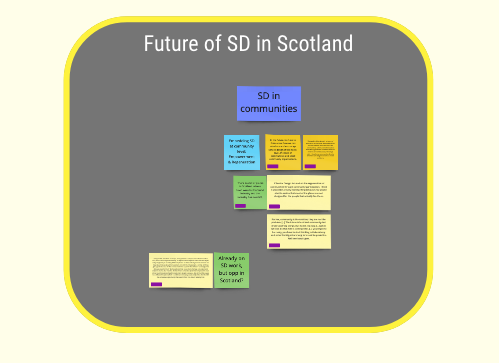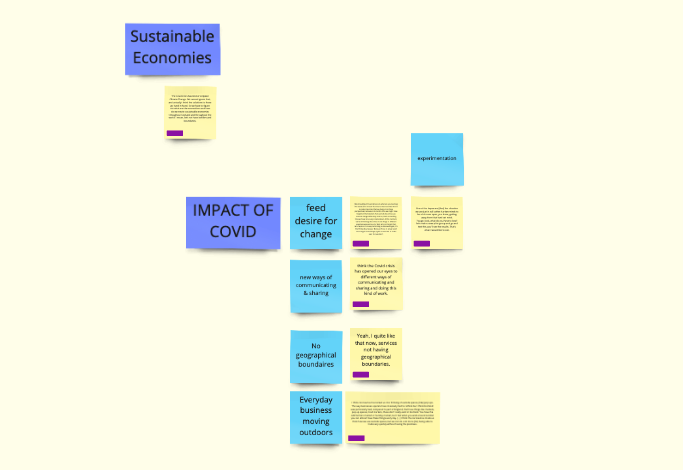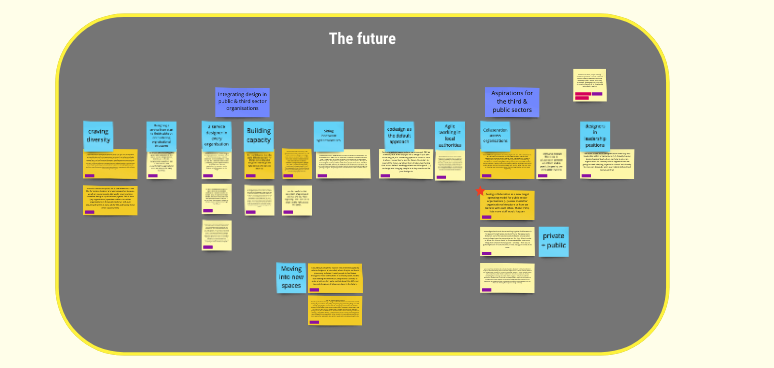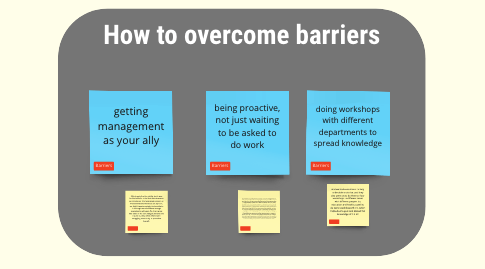Clusters of insights - quick access
- Service Design in communities
- Impact of Covid
- Public and 3rd sector: integrating design and other aspirations
- How to overcome barriers
Service Design in communities

Access the part of the Miro Board represented in the image
List of clusters of insights
Select one of the clusters of insights to see the quotes supporting it. Select it again to hide the quotes.
Embedding SD at community level: empowerment and regeneration
- In the future, we have to think about how we can introduce and encourage service design at the micro-level, the level of communities and small community organisations
- We need to think about it in terms of education and schools. We need to think about it in terms of healthcare in the community. [...] We have to think about how the big problems that face Scotland in terms of homelessness, the drugs crisis - How those communities directly affected can design solutions to those problems
- If Service Design focused on the regeneration of communities through community participation, I think it would be a really exciting thing because you would start to realise that most of the places are not designed for the people that actually live there
- For me, community is the solution; they are not the problem. [...] The future is local and community-led. And if anything brings that home, it's now. [...] when we look at whatever is coming next, [...] you've got to be ready, you have to start thinking collaboratively and enter the big picture long term and be proactive. We'll see how it goes
- Every health condition is unique, every patient is unique as our doctors tell us very often. But things like booking an appointment happens over and over again, every single day in so many different places. So if we actually set out and sort out how does that work well for a patient, for staff, for the system - so that all three get a good deal out of this and we back that up with the software we design, the data we need for it all. We have it and that is a pattern that we can adjust and adapt of course, but it works. And so this is a massive potential compared to even other countries where healthcare is more siloed, because... like in the USA you go to a different hospital which is a different company every single time. So the NHS has a massive opportunity there and I think it is about realising that
Other:
Sustainable economies
One quote: “The Covid crisis has kind of eclipsed Climate Change. We cannot ignore that, and actually I think the solutions to those go hand in hand. So we have to figure out what are the connections and how do we create sustainable economies throughout Scotland and throughout the world. I mean, let’s not have borders and boundaries.”
Impact of Covid

Access the part of the Miro Board represented in the image
List of clusters of insights
Select one of the clusters of insights to see the quotes supporting it. Select it again to hide the quotes.
Experimentation
- One of the hopes are [that] the situation we are just in will soften harden minds to be a bit more open, you know, getting away from that hard set mind. You go: look, what do you have to lose? let's make a wee pilot group and go and test this, you'll see the results. That's what I would like to see
Feed desire for change
- [We should] put the emphasis on what are you learning this week; what should the future cities look like? And it is really important that we hang on to those perspectives, because in 6 months time we might have forgotten that idealism that we had about how we could do things differently. And so, that’s something that we have to be very careful about. At the moment, we're all thinking about how to do things in different ways because we have to. Well, let’s not forget that, let's capture it to keep reminding us. Because again, it's that thing about power. Because those in power want us to forget those things, right? So we have to make sure that we don't
New ways of communicating & sharing
- Think the Covid crisis has opened our eyes to different ways of communicating and sharing and doing this kind of work
No geographical boundaires
- Yeah, I quite like that now, services not having geographical boundaries
Everyday business moving outdoors
- I think coronavirus has kicked us into thinking of outside spaces, [like] pop ups. The way businesses operate have massively had to rethink but I think Scotland was particularly bad, compared to part of England, that have things like markets, pop up spaces, food markets, these don't really exist in Scotland. You have the odd farmers market or Sunday market, but I feel when you walk around London you can almost have these things every day. [...] I think the coronavirus made us think how we use outside spaces, but we can do a lot more [for] being able to trade very quickly without having the premises
Public and 3rd sector: integrating design and other aspirations

Access the part of the Miro Board represented in the image
List of clusters of insights
Select one of the clusters of insights to see the quotes supporting it. Select it again to hide the quotes.
Craving diversity
- It would contribute quite a lot to the retentions. I feel like for service designer and user researcher, because we all are young people. We would never envision ourselves being in a job for twenty years. This is how [my organisation] operates and I‘m sure other organisations in the public sector as well, just assuming that this is not a job for life and having these other opportunities
- It would contribute quite a lot to the retentions. I feel like for service designer and user researcher, because we all are young people. We would never envision ourselves being in a job for twenty years. This is how [my organisation] operates and I‘m sure other organisations in the public sector as well, just assuming that this is not a job for life and having these other opportunities
Designing a service from start to finish without encountering organisational structures
- My dream, where I want to get to with the [organisation], is like classic service design fashion, like the gov.uk model. Completing a service from start to finish without ever encountering the organisational structure. We‘re so far away from that
A service designer in every organisation
- I think there should be a service designer in every organisation. I think there should be someone who brings a different perspective in every organisation. That's the gap, but it is also the dream, isn’t it? [...] I suppose I want to see it everywhere. I would like to see that every organisation has access to a service designer or tools to support service design
- I'd like to see embedded designer in organisation, like in planning for example, for 6 months, 9 months for example, going through a phase where folks are with them in lots of way. Why can't a founder be part of that and a person from the community to learn, or take a courses or whatever else, to get that skills set
- Something that is more mature, slightly more evolved, more sophisticated and realistic. Sometimes I think that it is still a novelty, it is not a core part of how people work. So i think having that more centralised core aspect would be really fascinating. You know, like technical architects now... oh yeah, it’s just a technical architect. If you have any sort of technical capability you need to have an architect and developers. But designers are often still ‘nice to have’ not a ‘must have’. Moving into that ‘must have’ space would be really positive. And that relationship being more sophisticated in thinking about the domain in which it is operating in and how we handle its complexity
Building capacity
- For the 3rd sector it can be quite difficult especially for things like funding and things like that? to get the right skills in, and to keep them in
- It’s almost like we don’t have to talk about it anymore. It’s a thing that is just in the bones of how we work. It is inherently that shared language. That we’ve been able to demonstrate that we can do this stuff, and it is not something that we are trying to persuade people think about. It is not something we are having to use all these labels for, it’;s just how we work. And that is across the entire public sector. You know, that I could speak to someone who were procuring a service from the public sector, and they know. They think and they know what is important in terms of public services in Scotland. That’s ‘we don’t need to exist anymore’. We just are
- How it works with contractors, and private sector as well, a lot of PS and 3rd sector are now starting to see design roles still on quite short terms contracts quite often, but if you have an internal teams and then you are getting a contractor, how do they work together and make it collaborative and work together and not against each other? There is a positive intent but then how do you make it easier for people to actually do that and properly embed it
- You do need a kind of ecosystem of agency and external and you need capability - like I don’t think anyone is the right, one or the other,
Sitting in between systems / sectors
- [The way] we procure design work is that there are projects for designers to get involved within like health care, or social care, or housing, or transport. We‘re not yet at a stage, where we can put someone in the middle of all of those things. Those things will always joint up together, and you will always be at the edge of one leaning into another, and that will be where projects make sense. But what if we would encourage people to do design work that actively joins them up so that our health care, social care, and transport systems are actually designed together. [Having] designers [and] design teams to sit in between so that we‘re less siloed
Co-design as the default approach
- So, being able to have a culture, where we got [SD] as a default, that is the way you do it, design is just part of the day job, not something special or unusual. That is where I would like to see the future. Co-design for most of the things, whatever form it takes. Just having that as our default working pattern would be good. [...] co-design and bringing people in at day one should be your first go to
Agile working in local authorities
- Why is there not an agile team in my local authority that works across silos and just when the data come in, a given task on a service and do something with that and go do! Again this seems to be these simple things that seem to be at odds when it comes to councils. I'd like to see local authorities etc.. really taking this on. In other words, it's really that consistency across the piece that will help to break silos, it's about efficiencies, not just in budgets but to make sure the service fits the need, and I think particularly now more than ever
Collaboration across organisations
- Lots of different organisations are coming together to look at the same issue. So let’s say there’s a consultation or an engagement piece, then all these organisations should be doing it together rather than separately. Instead of asking ‘what is the public experience of X organisation in Scotland during lockdown’ we could be asking ‘What is the public experience of public services during lockdown. If we’re all doing that research together, we design much better public services and then the public engages with us once rather than four times. So there has been conversation about this for a long time but nothing really happening
- I think what I would like to see is collaboration between all of them and in particular getting the third sector involved
- Seeing collaboration as a new target operating model for public sector organisations [...] a new model for organisational structure or how we behave with each other. Then I think, lots more stuff would happen
Moving into new spaces
- I would love people to explore new interesting places where designers are needed, where they’ve not been previously included. I want people to feel brave enough to invite themselves in to those places. And to start seeing themselves as people who can help to solve problems. I‘m quite excited about the different types of designers, that we can have in the future
- How do you feel about activism? How do you feel about being a designer within the black lives matter movement? Taking all your skills for storytelling and prototyping and making things real and actually applying that towards climate emergency or towards some form of activism that probably needs designers but doesn’t necessarily know how to ask for them. We tend to think of becoming a designer and joining an agency or joining a team, but could it be more fluid? Could the skill set of being a facilitator, of being a storyteller, of being a problem solver, fit in so many more things that need to be advanced very quickly at the moment. I‘m quite excited about that. I try to push other people into jobs, which I would wish to be brave enough to do
Private + public
- More aligned and much closer working together. Public sector is not always the right place and doesn't have the resources to deliver on a lot of the service needs of citizens, private sector doesn't always have the perspective and the right driver in order to deliver for citizens needs, so there needs to be much more integration between the two [public / private]. I think we are quite impressive in Scotland still but there are opportunities to do more
- You know they sometime do a chunk of work in discovery but then a different company does something else and at each stage, it's like a whole process, which is not the best way of doing it. I think it's good that there is a SAtSD because, there is the intent there, but I think in order for it to really have impact, it's like something has to change to enable that to happen I think, there is bit of a disconnect between that, so in order to really help that approach to happen PS and 3rd sector work together to do certain things, because there is a lot of overlap in service where other organisations signpost and things like that, but there are all doing their separate design of things
Designers in leadership positions
- I want to see more people in design leadership positions. I want to see more women in design leadership positions. The side projects I choose to do in my spare time, are helping to build up that community of people to be the potential future design leaders
- We want to see more designers work their way into leadership within organisations. [...] Actually, having design leadership at a level can help to steer an organisation. As so many of our organisations are going to need adapting in years to come if not already. So, how can design be seen as a helpful skill and tool to manage that
How to overcome barriers

Access the part of the Miro Board represented in the image
List of clusters of insights
Select one of the clusters of insights to see the quotes supporting it. Select it again to hide the quotes.
Getting management as your ally
- Which again had its pitfalls, but it also had its benefits in the fact that whenever we introduced it to large scale projects or transformations there was an ally to it, we didn’t have to explain the benefits to it although we would have enough examples to call upon. So, there were two sides of the coin. We got attraction to it quite quickly, while others were struggling more to try to prove the benefit
Being proactive, not just waiting to be asked to do work
- My aspiration is if I just do the work for myself, [...] I am just starting to work out what a good [service] looks like and designing for service by myself without anyone telling me to do it. And I will continue doing that. And then if some decision comes in, some commission, I can say ‘oh, is it about [this service]? This is what I know about [it]’. And so I front load my own process, in that way I can say, ‘ and actually all of this is evidence based, this is what I’ve done. So that’s a way to be quick and respond without just-- it’s being proactive rather than just rushing around from all these different things [48:59 not sure what she says] and trying to like feed them all. It’s almost impossible and you always end up doing slightly shitty work cause everything is a rush, and other people will be faster cause they are not doing a proper design process. So I think that’s my current tactic. Can I form load it all, and in the meantime, well right now I’m not really asked to do much on products or projects. But if I am, I’ll do my best. But my priority should be the front-loading or the establishing all these patterns and all this. Which I don’t know if it is possible, it seems like a vast job. But I feel like I can make more difference on that than going to advocate for design on a product that needs to be shifted in two weeks
Doing workshops with different departments to spread knowledge
- And we had consultants to help to be able to do that and they also went on to do three or four workshops in different areas with different people. So, education and health as well to do some workshops there, which helped us to gain and spread the knowledge of it a bit